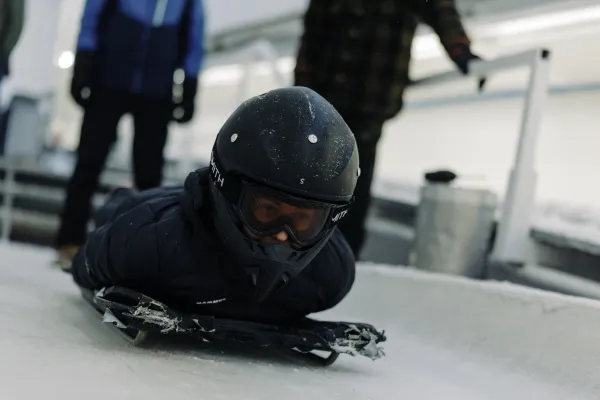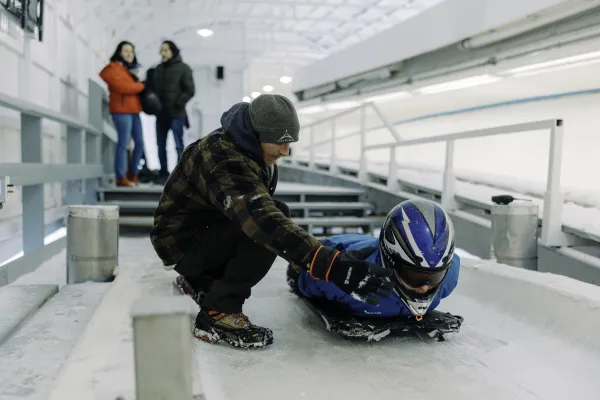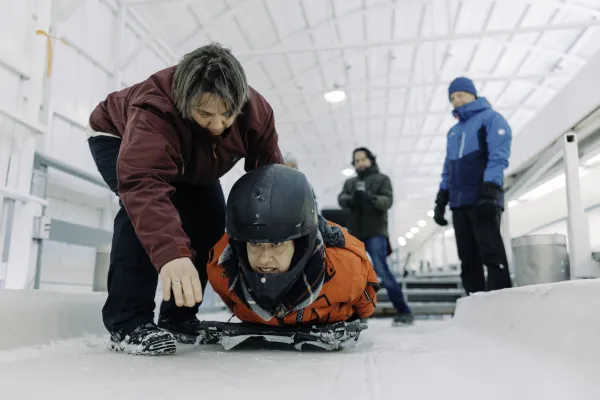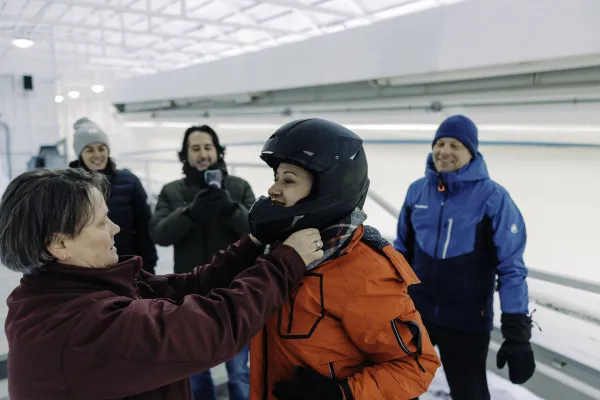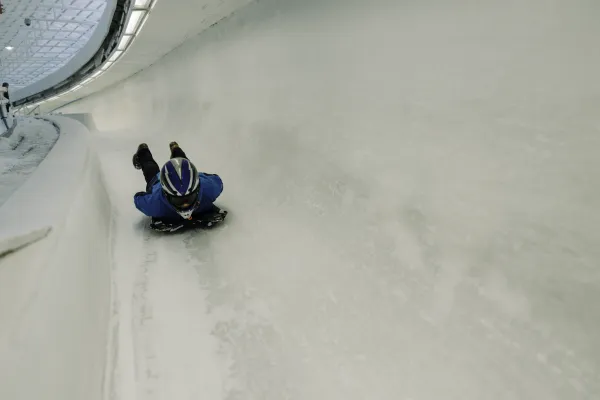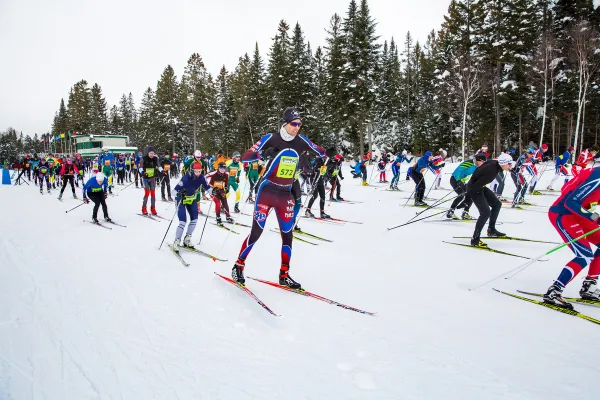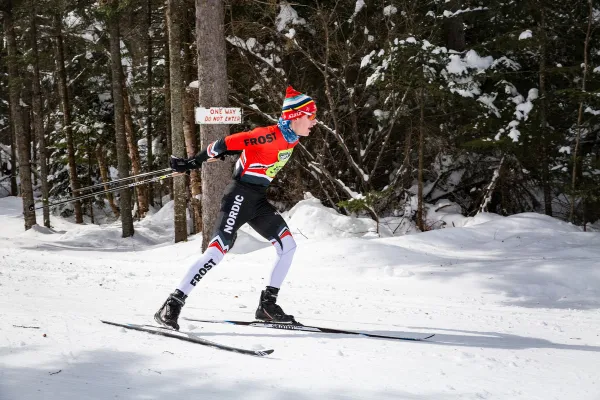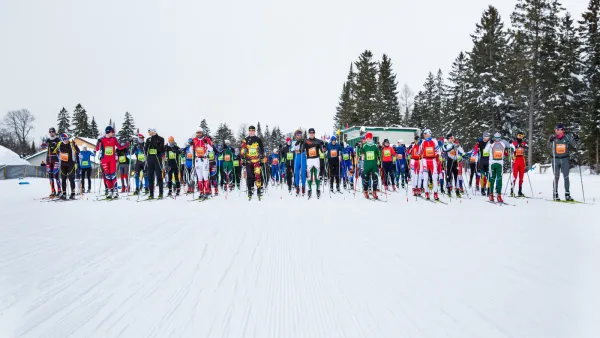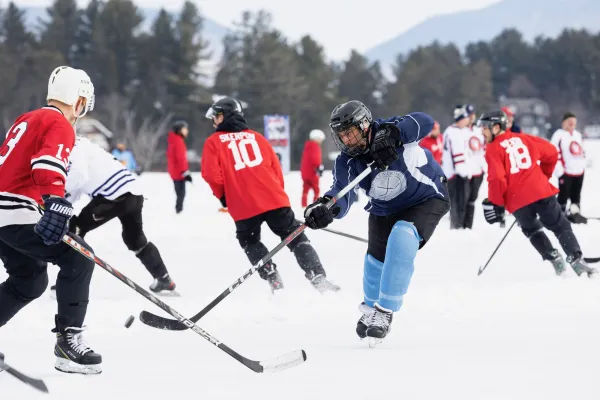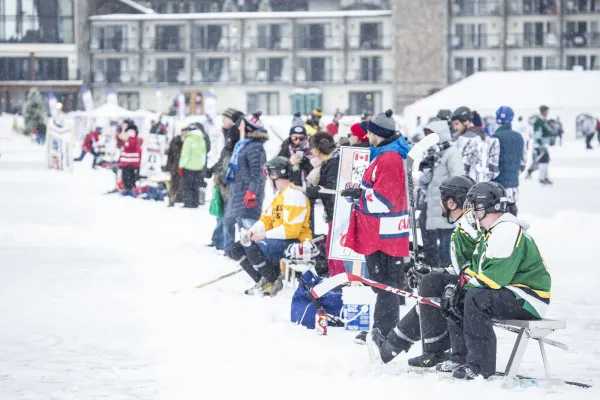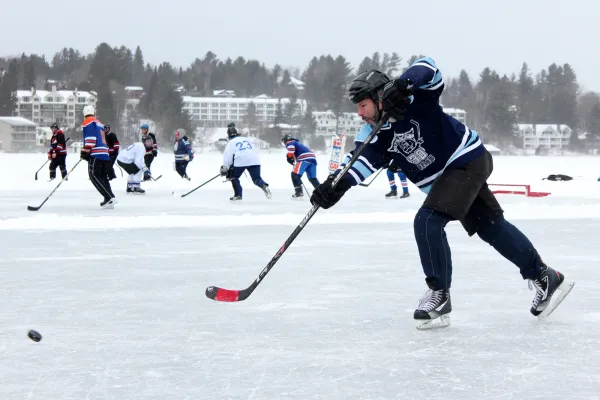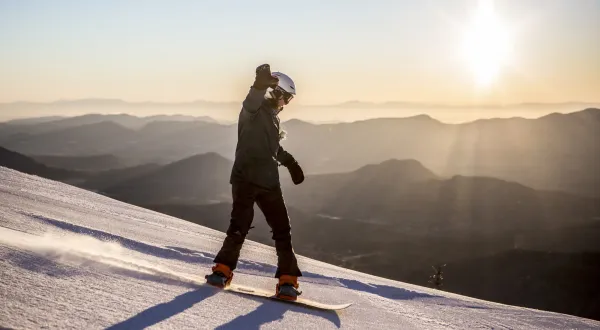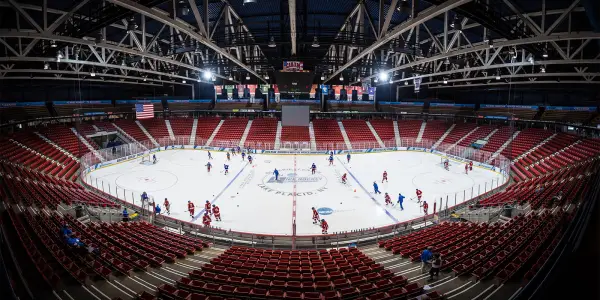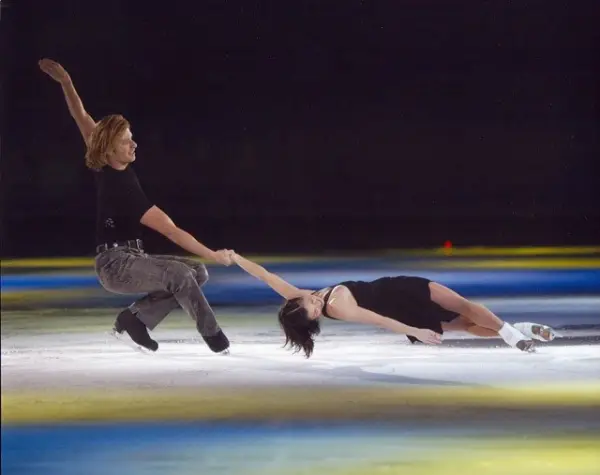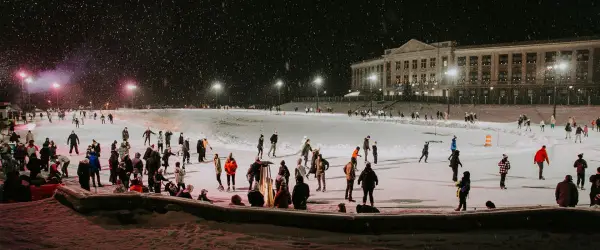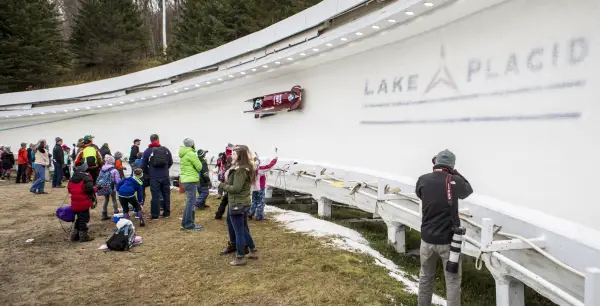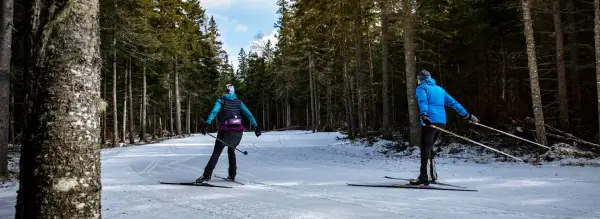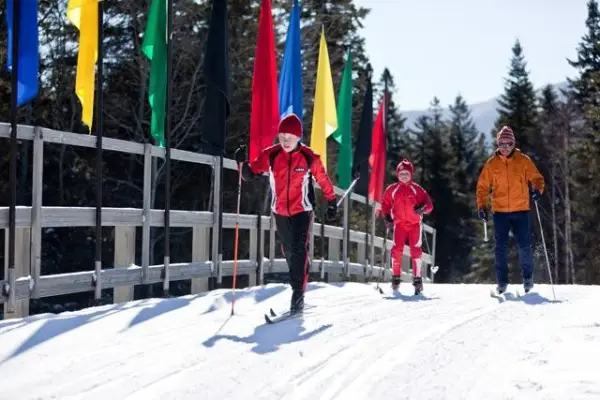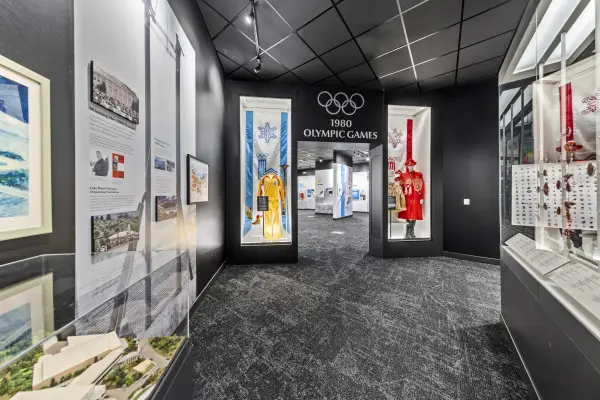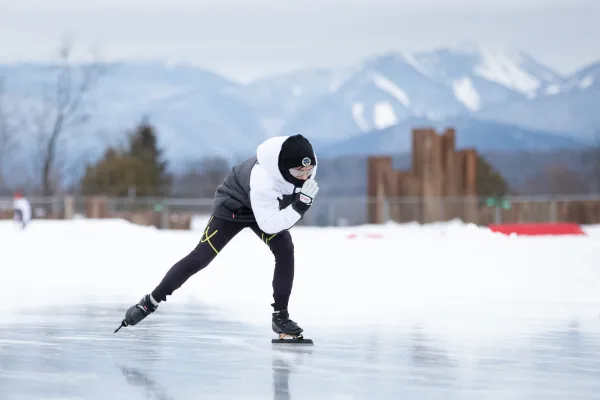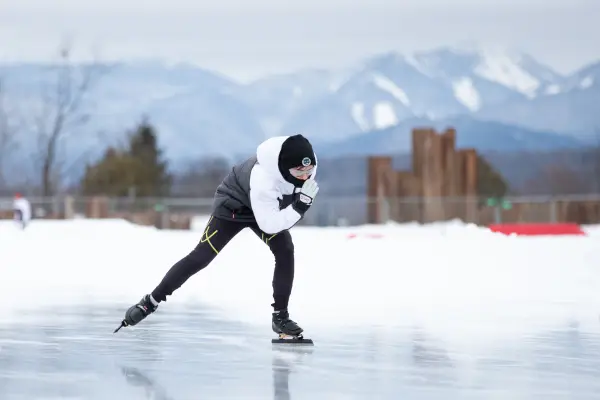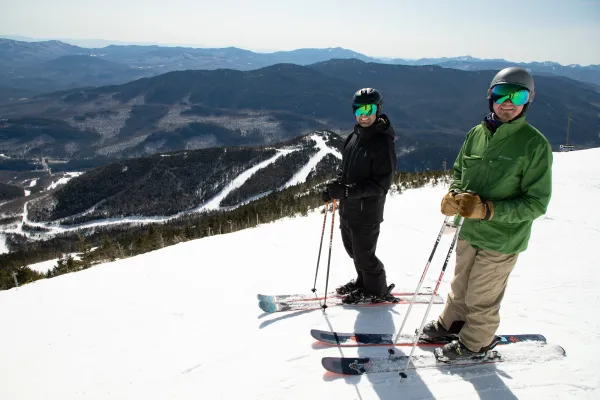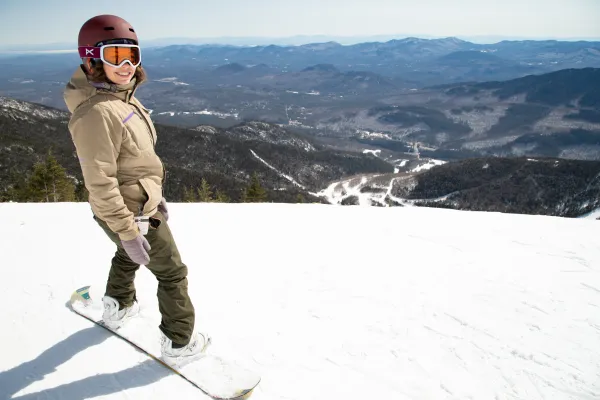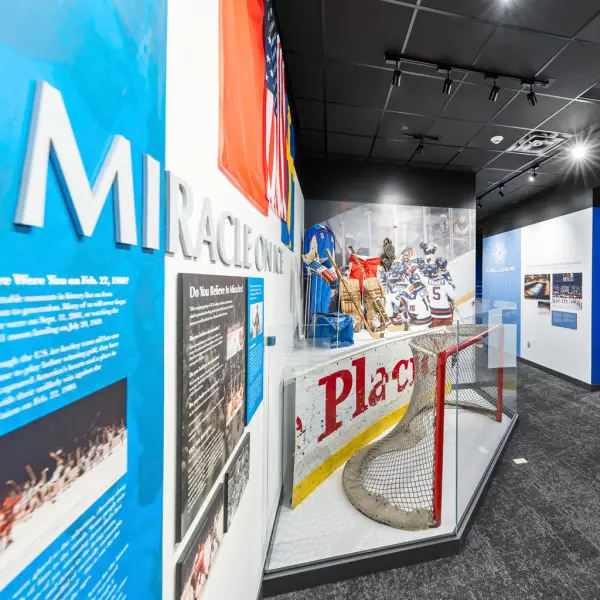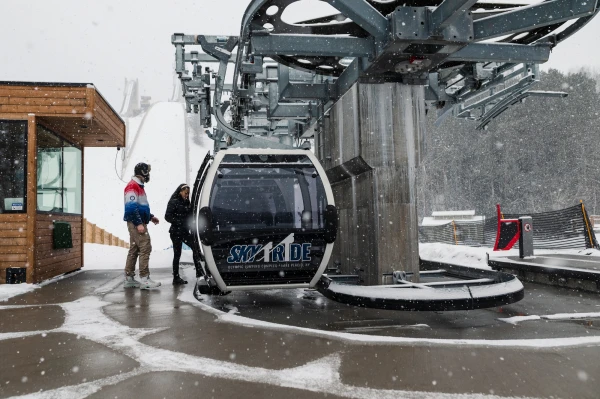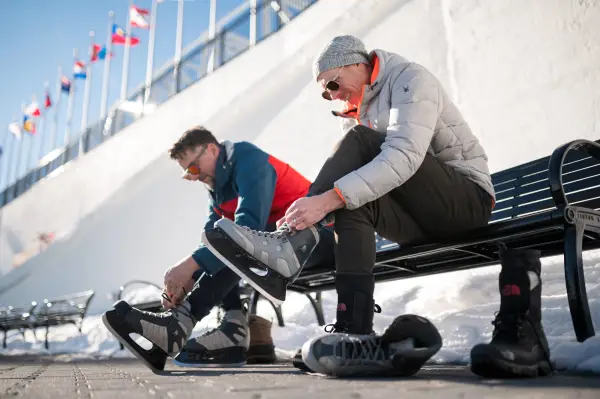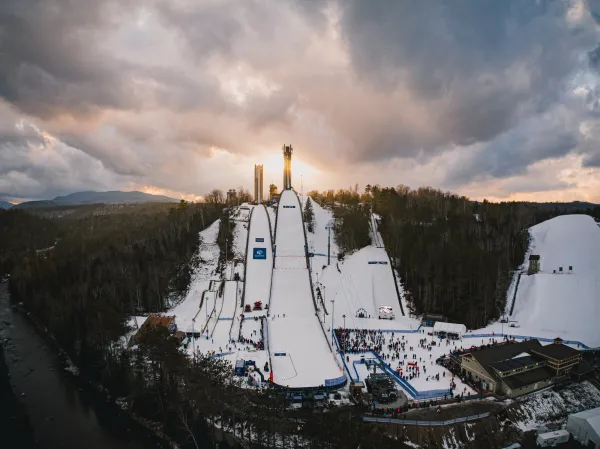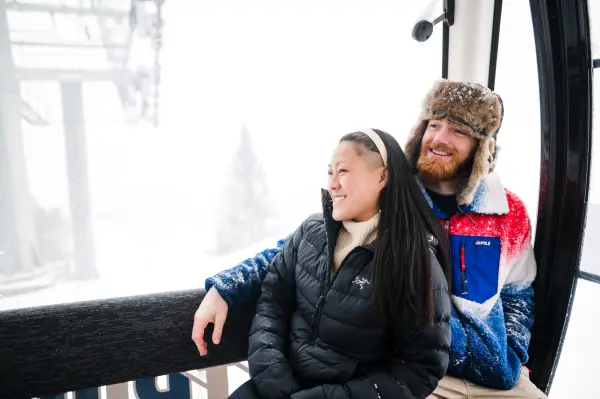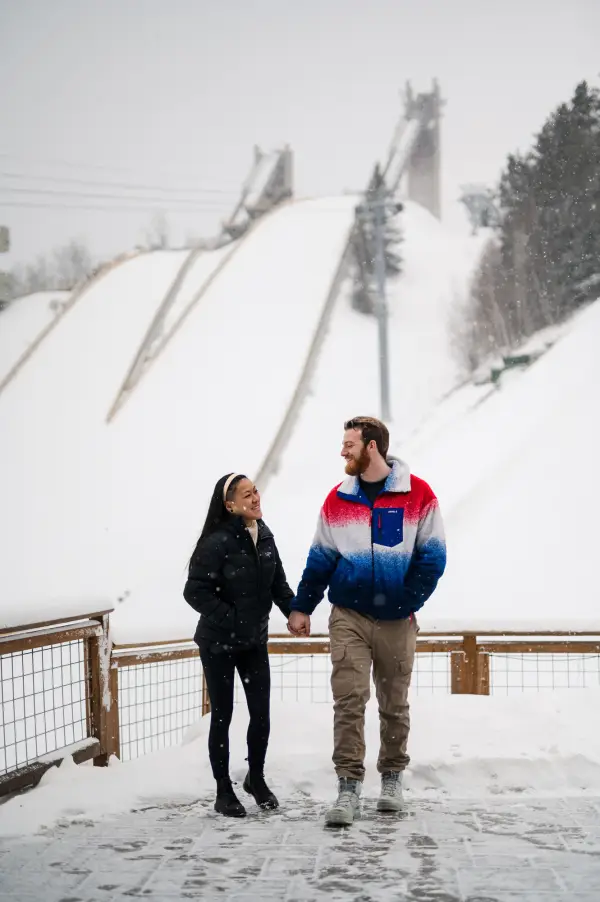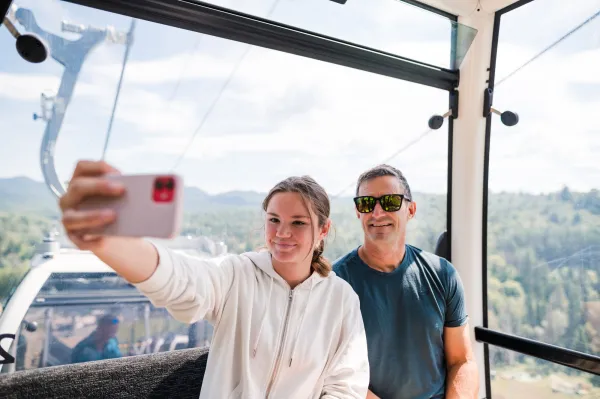1932 -1980: The Winter Olympics come to Lake Placid
Melvil Dewey's son Godfrey Dewey is responsible for securing the bid for the third Olympic Winter Games. Many were skeptical about Lake Placid's chances, but once the bid was awarded in 1929, the Town not only supported the effort, but it made a standout decision: it voted in a new tax to pay the town's portion of the 1932 games. This unique legislation created and funded the North Elba Park District, which, along with state and federal funding, facilitated the construction of the venues for the '32 games; all accomplished during the Great Depression.
The Olympic venues built for the 1932 Games were designed for future use. The arena, with its refrigerated floor, allowed the presentation of ice shows year round. The cachet of 'Lake Placid' attracted celebrities of the time, many of whom were crowned at the Winter Carnival: Roy Rogers, Perry Como, and Kirk Douglas among them. Arthur Godfrey broadcast his radio and TV show from the arena, and Kate Smith was a long time summer resident. This high profile activity kept Lake Placid on the media agenda and in the public eye throughout the 40's and 50's.
The oval, an outdoor refrigerated surface, was built adjacent to the local high school and could also be used for track in the summer seasons. During the 1932 Games, it was at this facility that local athlete Jack Shea (grandfather of skeleton racer Jimmy Shea) won his two gold medals.
The arena facility was home to another economic driver, and this one wasn't forecasted. Just as the sport of speed skating supported the association between Lake Placid and winter sports prior to the 1932 Games, figure skating became synonymous with Lake Placid through the 1970s. The Lake Placid figure skating program, led by professional Gustave Lussi, produced a dynasty of Olympic skating athletes from the late '30s through the '70s; most notable among them Dick Button. Almost every US Olympic figure skater in the '60s and '70s either trained at Lake Placid at one time or had skated in the arena's ice shows.

The next steps
Following the 1932 Games, community leaders continued to promote the area as a premier winter sports center. They pursued national and international events, and maintained and upgraded the sports facilities as much as possible. The important addition of an alpine sporting venue was accomplished in 1958 with the development of Whiteface Mountain. In 1967, an addition to the arena included another rink. However, the facilities really needed major funding to appropriately modernize them, and the general consensus was that the way to accomplish this was to host a very big event.
Although Lake Placid continued to position itself as a major winter sports center, hosting major international sports competitions that included the World Nordic Championships in 1950, and multiple World Bobsled Championships, it was the World University Games (FISU) in 1972 that made a statement to the world. This was the first time that the FISU Games were held in the U.S. It was the biggest international multi-sport winter event outside of an Olympics, featuring 500 athletes, from 23 countries, in 27 events. The magnitude of the FISU Games showcased Lake Placid's ability to host an international event of this caliber.
37
1,072
38
100
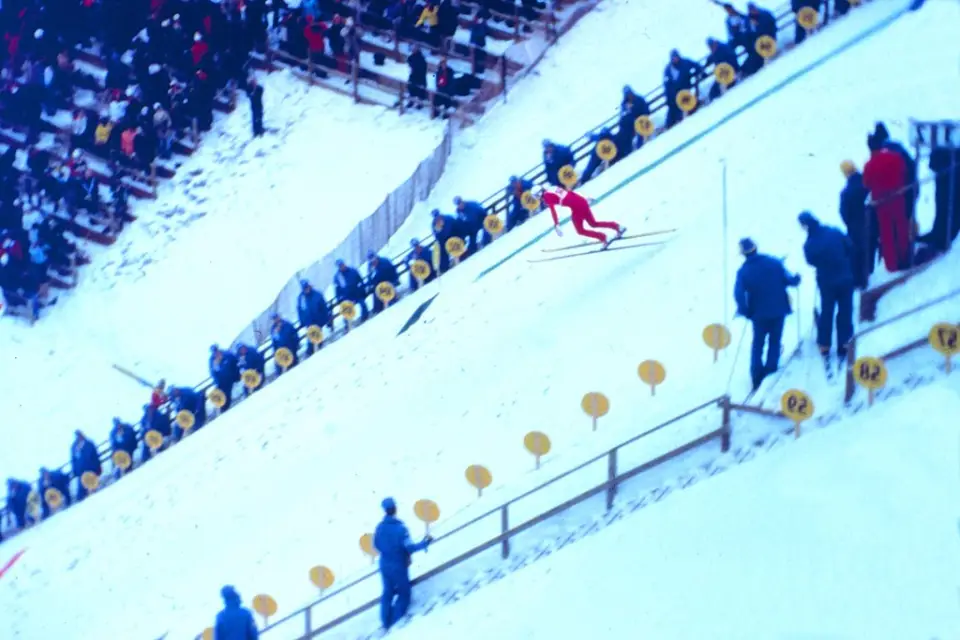
1980 Olympic Winter Games
From 1950 on, individuals from the community infiltrated the winter sports scene with the specific objective of bringing the Olympics back to Lake Placid. Every major winter sport had an official from Lake Placid in its ranks. A nucleus of extraordinary and somewhat stubborn individuals were responsible for bringing the Games back to this little village, spending 20 years of their lives dedicated to this process. They traveled worldwide, unpaid for their efforts. They made themselves known to the IOC members, including the President of the Organization. And, they prepared seven bids, three of which were approved by the USOC. In 1964, 1973, and finally in 1974, these bids were presented to the IOC.
The tremendous efforts of many individuals resulted in a globally successful event that just happened to produce some of the most significant sports moments in U.S. history.
The 1980 Games had a great impact on the infrastructure of the community. In addition to the updated Olympic facilities, the private sector made sizable investments for the Games. A great sense of pride in welcoming the world, and the potential return on investment, compelled most lodging properties to upgrade their facilities.
Probably the biggest consequence of the 1980 Games was the state's commitment to the sports venues. In 1981, New York state announced its decision to place the responsibility for maintaining, managing, and promoting all of the Olympic venues under one organization, the New York Olympic Regional Development Authority (ORDA). ORDA's key initiatives have been instrumental in nurturing Lake Placid's status as a world class winter sports center. Over the last 23 years, initiatives have included continued bidding on international winter sports events, construction of the Olympic Training Center in 1995, construction of the new combined bobsled, luge and skeleton run in 2000, improvements at Whiteface Mountain including the addition of a gondola, and most recently, the construction of the new Conference Center at Lake Placid.
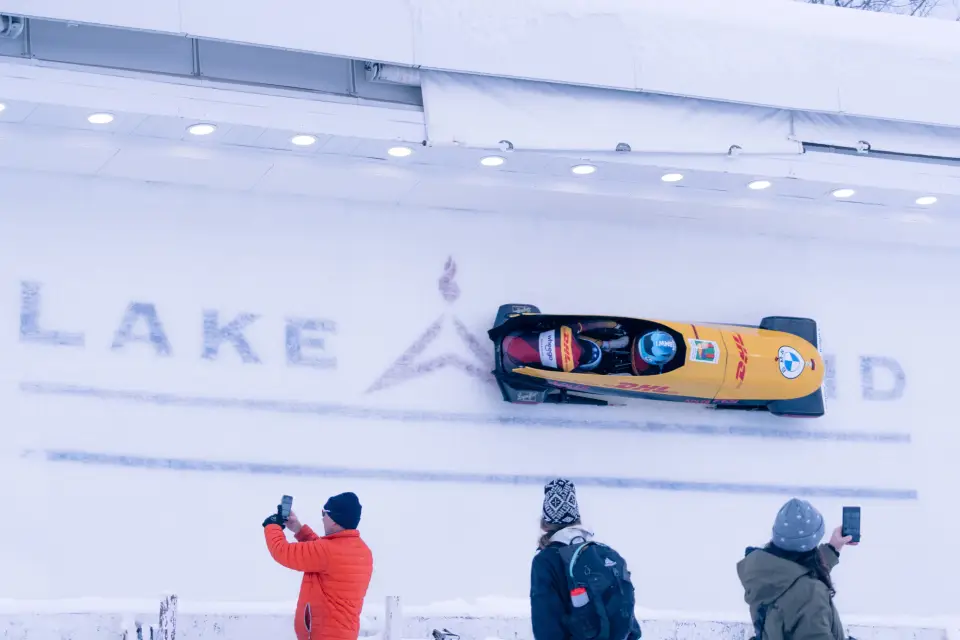
Lake Placid today
Throughout the 1980s and 1990s, the area has continued to host a variety of competitive events, and to welcome participants and enthusiasts from all over the globe. Thousands of Ironman Lake Placid competitors converge on the area in July, the Lake Placid Horse Shows have been an annual favorite for over 40 years, the popular Rugby Tournament, the Lake Placid Marathon, and the expanded lacrosse tournaments continue to grow.

Buongiorno, Milano Cortina!
Enjoy Olympic-style events
17
Dec 21, 2025
Dec 22, 2025
Dec 23, 2025
Dec 24, 2025
Jan 17, 2026
Jan 18, 2026
Jan 22, 2026
Jan 23, 2026
Jan 24, 2026
Jan 30, 2026
Jan 31, 2026
Feb 05, 2026
Feb 06, 2026
Feb 07, 2026
Feb 12, 2026
Feb 13, 2026
Feb 14, 2026
Feb 15, 2026
Feb 16, 2026
Feb 17, 2026
Feb 18, 2026
Feb 19, 2026
Feb 20, 2026
Feb 21, 2026
Feb 22, 2026
Feb 26, 2026
Feb 27, 2026
Feb 28, 2026
Mar 08, 2026
18
Dec 21, 2025
Dec 22, 2025
Dec 23, 2025
Dec 24, 2025
Jan 17, 2026
Jan 18, 2026
Jan 22, 2026
Jan 23, 2026
Jan 24, 2026
Jan 30, 2026
Jan 31, 2026
Feb 05, 2026
Feb 06, 2026
Feb 07, 2026
Feb 12, 2026
Feb 13, 2026
Feb 14, 2026
Feb 15, 2026
Feb 16, 2026
Feb 17, 2026
Feb 18, 2026
Feb 19, 2026
Feb 20, 2026
Feb 21, 2026
Feb 22, 2026
Feb 26, 2026
Feb 27, 2026
Feb 28, 2026
Mar 08, 2026
22
Dec 21, 2025
Dec 22, 2025
Dec 23, 2025
Dec 24, 2025
Jan 17, 2026
Jan 18, 2026
Jan 22, 2026
Jan 23, 2026
Jan 24, 2026
Jan 30, 2026
Jan 31, 2026
Feb 05, 2026
Feb 06, 2026
Feb 07, 2026
Feb 12, 2026
Feb 13, 2026
Feb 14, 2026
Feb 15, 2026
Feb 16, 2026
Feb 17, 2026
Feb 18, 2026
Feb 19, 2026
Feb 20, 2026
Feb 21, 2026
Feb 22, 2026
Feb 26, 2026
Feb 27, 2026
Feb 28, 2026
Mar 08, 2026
22
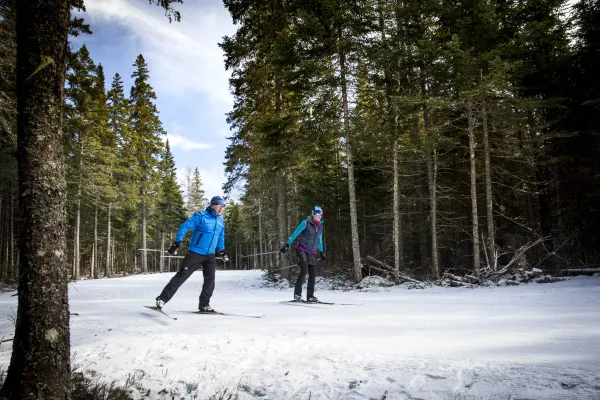
Jan 08, 2026
Jan 15, 2026
Jan 22, 2026
Jan 29, 2026
Feb 05, 2026
Feb 12, 2026
Feb 19, 2026
Mar 05, 2026
Mar 12, 2026
23
Dec 21, 2025
Dec 22, 2025
Dec 23, 2025
Dec 24, 2025
Jan 17, 2026
Jan 18, 2026
Jan 22, 2026
Jan 23, 2026
Jan 24, 2026
Jan 30, 2026
Jan 31, 2026
Feb 05, 2026
Feb 06, 2026
Feb 07, 2026
Feb 12, 2026
Feb 13, 2026
Feb 14, 2026
Feb 15, 2026
Feb 16, 2026
Feb 17, 2026
Feb 18, 2026
Feb 19, 2026
Feb 20, 2026
Feb 21, 2026
Feb 22, 2026
Feb 26, 2026
Feb 27, 2026
Feb 28, 2026
Mar 08, 2026
23

Dec 12, 2025
Jan 09, 2026
Jan 16, 2026
Jan 23, 2026
Jan 30, 2026
Feb 06, 2026
Feb 13, 2026
Feb 20, 2026
Feb 27, 2026
Mar 06, 2026
Mar 13, 2026
Mar 20, 2026
Mar 27, 2026
24
Dec 21, 2025
Dec 22, 2025
Dec 23, 2025
Dec 24, 2025
Jan 17, 2026
Jan 18, 2026
Jan 22, 2026
Jan 23, 2026
Jan 24, 2026
Jan 30, 2026
Jan 31, 2026
Feb 05, 2026
Feb 06, 2026
Feb 07, 2026
Feb 12, 2026
Feb 13, 2026
Feb 14, 2026
Feb 15, 2026
Feb 16, 2026
Feb 17, 2026
Feb 18, 2026
Feb 19, 2026
Feb 20, 2026
Feb 21, 2026
Feb 22, 2026
Feb 26, 2026
Feb 27, 2026
Feb 28, 2026
Mar 08, 2026
29

Jan 08, 2026
Jan 15, 2026
Jan 22, 2026
Jan 29, 2026
Feb 05, 2026
Feb 12, 2026
Feb 19, 2026
Mar 05, 2026
Mar 12, 2026
30
Dec 21, 2025
Dec 22, 2025
Dec 23, 2025
Dec 24, 2025
Jan 17, 2026
Jan 18, 2026
Jan 22, 2026
Jan 23, 2026
Jan 24, 2026
Jan 30, 2026
Jan 31, 2026
Feb 05, 2026
Feb 06, 2026
Feb 07, 2026
Feb 12, 2026
Feb 13, 2026
Feb 14, 2026
Feb 15, 2026
Feb 16, 2026
Feb 17, 2026
Feb 18, 2026
Feb 19, 2026
Feb 20, 2026
Feb 21, 2026
Feb 22, 2026
Feb 26, 2026
Feb 27, 2026
Feb 28, 2026
Mar 08, 2026
30
Jan 30, 2026
Jan 31, 2026
Feb 01, 2026
30

Dec 12, 2025
Jan 09, 2026
Jan 16, 2026
Jan 23, 2026
Jan 30, 2026
Feb 06, 2026
Feb 13, 2026
Feb 20, 2026
Feb 27, 2026
Mar 06, 2026
Mar 13, 2026
Mar 20, 2026
Mar 27, 2026
31
Dec 21, 2025
Dec 22, 2025
Dec 23, 2025
Dec 24, 2025
Jan 17, 2026
Jan 18, 2026
Jan 22, 2026
Jan 23, 2026
Jan 24, 2026
Jan 30, 2026
Jan 31, 2026
Feb 05, 2026
Feb 06, 2026
Feb 07, 2026
Feb 12, 2026
Feb 13, 2026
Feb 14, 2026
Feb 15, 2026
Feb 16, 2026
Feb 17, 2026
Feb 18, 2026
Feb 19, 2026
Feb 20, 2026
Feb 21, 2026
Feb 22, 2026
Feb 26, 2026
Feb 27, 2026
Feb 28, 2026
Mar 08, 2026
31
Jan 30, 2026
Jan 31, 2026
Feb 01, 2026
1
Jan 30, 2026
Jan 31, 2026
Feb 01, 2026
1
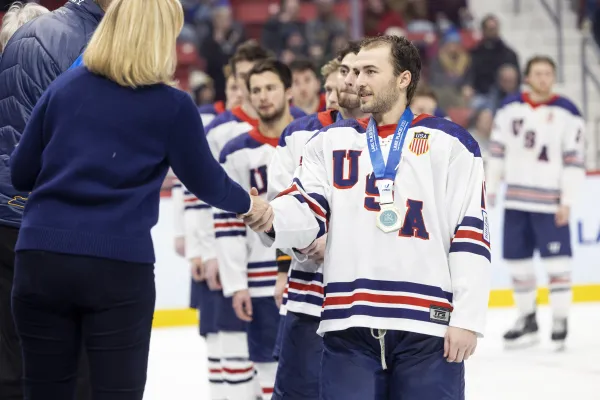
Feb 01, 2026
Feb 02, 2026
Feb 03, 2026
Feb 04, 2026
Feb 05, 2026
Feb 06, 2026
Feb 07, 2026
Feb 08, 2026
Feb 09, 2026
Feb 10, 2026
Feb 11, 2026
Feb 12, 2026
Feb 13, 2026
Feb 14, 2026
Feb 15, 2026
Feb 16, 2026
Feb 17, 2026
Feb 18, 2026
Feb 19, 2026
Feb 20, 2026
Feb 21, 2026
Feb 22, 2026
Feb 23, 2026
Feb 24, 2026
Feb 25, 2026
Feb 26, 2026
Feb 27, 2026
Feb 28, 2026
1

Feb 01, 2026
Feb 02, 2026
Feb 03, 2026
Feb 04, 2026
Feb 05, 2026
Feb 06, 2026
Feb 07, 2026
Feb 08, 2026
Feb 09, 2026
Feb 10, 2026
Feb 11, 2026
Feb 12, 2026
Feb 13, 2026
Feb 14, 2026
Feb 15, 2026
Feb 16, 2026
Feb 17, 2026
Feb 18, 2026
Feb 19, 2026
Feb 20, 2026
Feb 21, 2026
Feb 22, 2026
Feb 23, 2026
Feb 24, 2026
Feb 25, 2026
Feb 26, 2026
Feb 27, 2026
Feb 28, 2026
2

Feb 01, 2026
Feb 02, 2026
Feb 03, 2026
Feb 04, 2026
Feb 05, 2026
Feb 06, 2026
Feb 07, 2026
Feb 08, 2026
Feb 09, 2026
Feb 10, 2026
Feb 11, 2026
Feb 12, 2026
Feb 13, 2026
Feb 14, 2026
Feb 15, 2026
Feb 16, 2026
Feb 17, 2026
Feb 18, 2026
Feb 19, 2026
Feb 20, 2026
Feb 21, 2026
Feb 22, 2026
Feb 23, 2026
Feb 24, 2026
Feb 25, 2026
Feb 26, 2026
Feb 27, 2026
Feb 28, 2026
2

Feb 01, 2026
Feb 02, 2026
Feb 03, 2026
Feb 04, 2026
Feb 05, 2026
Feb 06, 2026
Feb 07, 2026
Feb 08, 2026
Feb 09, 2026
Feb 10, 2026
Feb 11, 2026
Feb 12, 2026
Feb 13, 2026
Feb 14, 2026
Feb 15, 2026
Feb 16, 2026
Feb 17, 2026
Feb 18, 2026
Feb 19, 2026
Feb 20, 2026
Feb 21, 2026
Feb 22, 2026
Feb 23, 2026
Feb 24, 2026
Feb 25, 2026
Feb 26, 2026
Feb 27, 2026
Feb 28, 2026
3

Feb 01, 2026
Feb 02, 2026
Feb 03, 2026
Feb 04, 2026
Feb 05, 2026
Feb 06, 2026
Feb 07, 2026
Feb 08, 2026
Feb 09, 2026
Feb 10, 2026
Feb 11, 2026
Feb 12, 2026
Feb 13, 2026
Feb 14, 2026
Feb 15, 2026
Feb 16, 2026
Feb 17, 2026
Feb 18, 2026
Feb 19, 2026
Feb 20, 2026
Feb 21, 2026
Feb 22, 2026
Feb 23, 2026
Feb 24, 2026
Feb 25, 2026
Feb 26, 2026
Feb 27, 2026
Feb 28, 2026
3

Feb 01, 2026
Feb 02, 2026
Feb 03, 2026
Feb 04, 2026
Feb 05, 2026
Feb 06, 2026
Feb 07, 2026
Feb 08, 2026
Feb 09, 2026
Feb 10, 2026
Feb 11, 2026
Feb 12, 2026
Feb 13, 2026
Feb 14, 2026
Feb 15, 2026
Feb 16, 2026
Feb 17, 2026
Feb 18, 2026
Feb 19, 2026
Feb 20, 2026
Feb 21, 2026
Feb 22, 2026
Feb 23, 2026
Feb 24, 2026
Feb 25, 2026
Feb 26, 2026
Feb 27, 2026
Feb 28, 2026
Browse all
17
Dec 21, 2025
Dec 22, 2025
Dec 23, 2025
Dec 24, 2025
Jan 17, 2026
Jan 18, 2026
Jan 22, 2026
Jan 23, 2026
Jan 24, 2026
Jan 30, 2026
Jan 31, 2026
Feb 05, 2026
Feb 06, 2026
Feb 07, 2026
Feb 12, 2026
Feb 13, 2026
Feb 14, 2026
Feb 15, 2026
Feb 16, 2026
Feb 17, 2026
Feb 18, 2026
Feb 19, 2026
Feb 20, 2026
Feb 21, 2026
Feb 22, 2026
Feb 26, 2026
Feb 27, 2026
Feb 28, 2026
Mar 08, 2026
18
Dec 21, 2025
Dec 22, 2025
Dec 23, 2025
Dec 24, 2025
Jan 17, 2026
Jan 18, 2026
Jan 22, 2026
Jan 23, 2026
Jan 24, 2026
Jan 30, 2026
Jan 31, 2026
Feb 05, 2026
Feb 06, 2026
Feb 07, 2026
Feb 12, 2026
Feb 13, 2026
Feb 14, 2026
Feb 15, 2026
Feb 16, 2026
Feb 17, 2026
Feb 18, 2026
Feb 19, 2026
Feb 20, 2026
Feb 21, 2026
Feb 22, 2026
Feb 26, 2026
Feb 27, 2026
Feb 28, 2026
Mar 08, 2026
22
Dec 21, 2025
Dec 22, 2025
Dec 23, 2025
Dec 24, 2025
Jan 17, 2026
Jan 18, 2026
Jan 22, 2026
Jan 23, 2026
Jan 24, 2026
Jan 30, 2026
Jan 31, 2026
Feb 05, 2026
Feb 06, 2026
Feb 07, 2026
Feb 12, 2026
Feb 13, 2026
Feb 14, 2026
Feb 15, 2026
Feb 16, 2026
Feb 17, 2026
Feb 18, 2026
Feb 19, 2026
Feb 20, 2026
Feb 21, 2026
Feb 22, 2026
Feb 26, 2026
Feb 27, 2026
Feb 28, 2026
Mar 08, 2026
22

Jan 08, 2026
Jan 15, 2026
Jan 22, 2026
Jan 29, 2026
Feb 05, 2026
Feb 12, 2026
Feb 19, 2026
Mar 05, 2026
Mar 12, 2026
23
Dec 21, 2025
Dec 22, 2025
Dec 23, 2025
Dec 24, 2025
Jan 17, 2026
Jan 18, 2026
Jan 22, 2026
Jan 23, 2026
Jan 24, 2026
Jan 30, 2026
Jan 31, 2026
Feb 05, 2026
Feb 06, 2026
Feb 07, 2026
Feb 12, 2026
Feb 13, 2026
Feb 14, 2026
Feb 15, 2026
Feb 16, 2026
Feb 17, 2026
Feb 18, 2026
Feb 19, 2026
Feb 20, 2026
Feb 21, 2026
Feb 22, 2026
Feb 26, 2026
Feb 27, 2026
Feb 28, 2026
Mar 08, 2026
23

Dec 12, 2025
Jan 09, 2026
Jan 16, 2026
Jan 23, 2026
Jan 30, 2026
Feb 06, 2026
Feb 13, 2026
Feb 20, 2026
Feb 27, 2026
Mar 06, 2026
Mar 13, 2026
Mar 20, 2026
Mar 27, 2026
24
Dec 21, 2025
Dec 22, 2025
Dec 23, 2025
Dec 24, 2025
Jan 17, 2026
Jan 18, 2026
Jan 22, 2026
Jan 23, 2026
Jan 24, 2026
Jan 30, 2026
Jan 31, 2026
Feb 05, 2026
Feb 06, 2026
Feb 07, 2026
Feb 12, 2026
Feb 13, 2026
Feb 14, 2026
Feb 15, 2026
Feb 16, 2026
Feb 17, 2026
Feb 18, 2026
Feb 19, 2026
Feb 20, 2026
Feb 21, 2026
Feb 22, 2026
Feb 26, 2026
Feb 27, 2026
Feb 28, 2026
Mar 08, 2026
29

Jan 08, 2026
Jan 15, 2026
Jan 22, 2026
Jan 29, 2026
Feb 05, 2026
Feb 12, 2026
Feb 19, 2026
Mar 05, 2026
Mar 12, 2026
30
Dec 21, 2025
Dec 22, 2025
Dec 23, 2025
Dec 24, 2025
Jan 17, 2026
Jan 18, 2026
Jan 22, 2026
Jan 23, 2026
Jan 24, 2026
Jan 30, 2026
Jan 31, 2026
Feb 05, 2026
Feb 06, 2026
Feb 07, 2026
Feb 12, 2026
Feb 13, 2026
Feb 14, 2026
Feb 15, 2026
Feb 16, 2026
Feb 17, 2026
Feb 18, 2026
Feb 19, 2026
Feb 20, 2026
Feb 21, 2026
Feb 22, 2026
Feb 26, 2026
Feb 27, 2026
Feb 28, 2026
Mar 08, 2026
30
Jan 30, 2026
Jan 31, 2026
Feb 01, 2026
30

Dec 12, 2025
Jan 09, 2026
Jan 16, 2026
Jan 23, 2026
Jan 30, 2026
Feb 06, 2026
Feb 13, 2026
Feb 20, 2026
Feb 27, 2026
Mar 06, 2026
Mar 13, 2026
Mar 20, 2026
Mar 27, 2026
31
Dec 21, 2025
Dec 22, 2025
Dec 23, 2025
Dec 24, 2025
Jan 17, 2026
Jan 18, 2026
Jan 22, 2026
Jan 23, 2026
Jan 24, 2026
Jan 30, 2026
Jan 31, 2026
Feb 05, 2026
Feb 06, 2026
Feb 07, 2026
Feb 12, 2026
Feb 13, 2026
Feb 14, 2026
Feb 15, 2026
Feb 16, 2026
Feb 17, 2026
Feb 18, 2026
Feb 19, 2026
Feb 20, 2026
Feb 21, 2026
Feb 22, 2026
Feb 26, 2026
Feb 27, 2026
Feb 28, 2026
Mar 08, 2026
31
Jan 30, 2026
Jan 31, 2026
Feb 01, 2026
1
Jan 30, 2026
Jan 31, 2026
Feb 01, 2026
1

Feb 01, 2026
Feb 02, 2026
Feb 03, 2026
Feb 04, 2026
Feb 05, 2026
Feb 06, 2026
Feb 07, 2026
Feb 08, 2026
Feb 09, 2026
Feb 10, 2026
Feb 11, 2026
Feb 12, 2026
Feb 13, 2026
Feb 14, 2026
Feb 15, 2026
Feb 16, 2026
Feb 17, 2026
Feb 18, 2026
Feb 19, 2026
Feb 20, 2026
Feb 21, 2026
Feb 22, 2026
Feb 23, 2026
Feb 24, 2026
Feb 25, 2026
Feb 26, 2026
Feb 27, 2026
Feb 28, 2026
1

Feb 01, 2026
Feb 02, 2026
Feb 03, 2026
Feb 04, 2026
Feb 05, 2026
Feb 06, 2026
Feb 07, 2026
Feb 08, 2026
Feb 09, 2026
Feb 10, 2026
Feb 11, 2026
Feb 12, 2026
Feb 13, 2026
Feb 14, 2026
Feb 15, 2026
Feb 16, 2026
Feb 17, 2026
Feb 18, 2026
Feb 19, 2026
Feb 20, 2026
Feb 21, 2026
Feb 22, 2026
Feb 23, 2026
Feb 24, 2026
Feb 25, 2026
Feb 26, 2026
Feb 27, 2026
Feb 28, 2026
2

Feb 01, 2026
Feb 02, 2026
Feb 03, 2026
Feb 04, 2026
Feb 05, 2026
Feb 06, 2026
Feb 07, 2026
Feb 08, 2026
Feb 09, 2026
Feb 10, 2026
Feb 11, 2026
Feb 12, 2026
Feb 13, 2026
Feb 14, 2026
Feb 15, 2026
Feb 16, 2026
Feb 17, 2026
Feb 18, 2026
Feb 19, 2026
Feb 20, 2026
Feb 21, 2026
Feb 22, 2026
Feb 23, 2026
Feb 24, 2026
Feb 25, 2026
Feb 26, 2026
Feb 27, 2026
Feb 28, 2026
2

Feb 01, 2026
Feb 02, 2026
Feb 03, 2026
Feb 04, 2026
Feb 05, 2026
Feb 06, 2026
Feb 07, 2026
Feb 08, 2026
Feb 09, 2026
Feb 10, 2026
Feb 11, 2026
Feb 12, 2026
Feb 13, 2026
Feb 14, 2026
Feb 15, 2026
Feb 16, 2026
Feb 17, 2026
Feb 18, 2026
Feb 19, 2026
Feb 20, 2026
Feb 21, 2026
Feb 22, 2026
Feb 23, 2026
Feb 24, 2026
Feb 25, 2026
Feb 26, 2026
Feb 27, 2026
Feb 28, 2026
3

Feb 01, 2026
Feb 02, 2026
Feb 03, 2026
Feb 04, 2026
Feb 05, 2026
Feb 06, 2026
Feb 07, 2026
Feb 08, 2026
Feb 09, 2026
Feb 10, 2026
Feb 11, 2026
Feb 12, 2026
Feb 13, 2026
Feb 14, 2026
Feb 15, 2026
Feb 16, 2026
Feb 17, 2026
Feb 18, 2026
Feb 19, 2026
Feb 20, 2026
Feb 21, 2026
Feb 22, 2026
Feb 23, 2026
Feb 24, 2026
Feb 25, 2026
Feb 26, 2026
Feb 27, 2026
Feb 28, 2026
3

Feb 01, 2026
Feb 02, 2026
Feb 03, 2026
Feb 04, 2026
Feb 05, 2026
Feb 06, 2026
Feb 07, 2026
Feb 08, 2026
Feb 09, 2026
Feb 10, 2026
Feb 11, 2026
Feb 12, 2026
Feb 13, 2026
Feb 14, 2026
Feb 15, 2026
Feb 16, 2026
Feb 17, 2026
Feb 18, 2026
Feb 19, 2026
Feb 20, 2026
Feb 21, 2026
Feb 22, 2026
Feb 23, 2026
Feb 24, 2026
Feb 25, 2026
Feb 26, 2026
Feb 27, 2026
Feb 28, 2026
Browse all
17
Dec 21, 2025
Dec 22, 2025
Dec 23, 2025
Dec 24, 2025
Jan 17, 2026
Jan 18, 2026
Jan 22, 2026
Jan 23, 2026
Jan 24, 2026
Jan 30, 2026
Jan 31, 2026
Feb 05, 2026
Feb 06, 2026
Feb 07, 2026
Feb 12, 2026
Feb 13, 2026
Feb 14, 2026
Feb 15, 2026
Feb 16, 2026
Feb 17, 2026
Feb 18, 2026
Feb 19, 2026
Feb 20, 2026
Feb 21, 2026
Feb 22, 2026
Feb 26, 2026
Feb 27, 2026
Feb 28, 2026
Mar 08, 2026
18
Dec 21, 2025
Dec 22, 2025
Dec 23, 2025
Dec 24, 2025
Jan 17, 2026
Jan 18, 2026
Jan 22, 2026
Jan 23, 2026
Jan 24, 2026
Jan 30, 2026
Jan 31, 2026
Feb 05, 2026
Feb 06, 2026
Feb 07, 2026
Feb 12, 2026
Feb 13, 2026
Feb 14, 2026
Feb 15, 2026
Feb 16, 2026
Feb 17, 2026
Feb 18, 2026
Feb 19, 2026
Feb 20, 2026
Feb 21, 2026
Feb 22, 2026
Feb 26, 2026
Feb 27, 2026
Feb 28, 2026
Mar 08, 2026
22
Dec 21, 2025
Dec 22, 2025
Dec 23, 2025
Dec 24, 2025
Jan 17, 2026
Jan 18, 2026
Jan 22, 2026
Jan 23, 2026
Jan 24, 2026
Jan 30, 2026
Jan 31, 2026
Feb 05, 2026
Feb 06, 2026
Feb 07, 2026
Feb 12, 2026
Feb 13, 2026
Feb 14, 2026
Feb 15, 2026
Feb 16, 2026
Feb 17, 2026
Feb 18, 2026
Feb 19, 2026
Feb 20, 2026
Feb 21, 2026
Feb 22, 2026
Feb 26, 2026
Feb 27, 2026
Feb 28, 2026
Mar 08, 2026
22

Jan 08, 2026
Jan 15, 2026
Jan 22, 2026
Jan 29, 2026
Feb 05, 2026
Feb 12, 2026
Feb 19, 2026
Mar 05, 2026
Mar 12, 2026
23
Dec 21, 2025
Dec 22, 2025
Dec 23, 2025
Dec 24, 2025
Jan 17, 2026
Jan 18, 2026
Jan 22, 2026
Jan 23, 2026
Jan 24, 2026
Jan 30, 2026
Jan 31, 2026
Feb 05, 2026
Feb 06, 2026
Feb 07, 2026
Feb 12, 2026
Feb 13, 2026
Feb 14, 2026
Feb 15, 2026
Feb 16, 2026
Feb 17, 2026
Feb 18, 2026
Feb 19, 2026
Feb 20, 2026
Feb 21, 2026
Feb 22, 2026
Feb 26, 2026
Feb 27, 2026
Feb 28, 2026
Mar 08, 2026
23

Dec 12, 2025
Jan 09, 2026
Jan 16, 2026
Jan 23, 2026
Jan 30, 2026
Feb 06, 2026
Feb 13, 2026
Feb 20, 2026
Feb 27, 2026
Mar 06, 2026
Mar 13, 2026
Mar 20, 2026
Mar 27, 2026
24
Dec 21, 2025
Dec 22, 2025
Dec 23, 2025
Dec 24, 2025
Jan 17, 2026
Jan 18, 2026
Jan 22, 2026
Jan 23, 2026
Jan 24, 2026
Jan 30, 2026
Jan 31, 2026
Feb 05, 2026
Feb 06, 2026
Feb 07, 2026
Feb 12, 2026
Feb 13, 2026
Feb 14, 2026
Feb 15, 2026
Feb 16, 2026
Feb 17, 2026
Feb 18, 2026
Feb 19, 2026
Feb 20, 2026
Feb 21, 2026
Feb 22, 2026
Feb 26, 2026
Feb 27, 2026
Feb 28, 2026
Mar 08, 2026
29

Jan 08, 2026
Jan 15, 2026
Jan 22, 2026
Jan 29, 2026
Feb 05, 2026
Feb 12, 2026
Feb 19, 2026
Mar 05, 2026
Mar 12, 2026
30
Dec 21, 2025
Dec 22, 2025
Dec 23, 2025
Dec 24, 2025
Jan 17, 2026
Jan 18, 2026
Jan 22, 2026
Jan 23, 2026
Jan 24, 2026
Jan 30, 2026
Jan 31, 2026
Feb 05, 2026
Feb 06, 2026
Feb 07, 2026
Feb 12, 2026
Feb 13, 2026
Feb 14, 2026
Feb 15, 2026
Feb 16, 2026
Feb 17, 2026
Feb 18, 2026
Feb 19, 2026
Feb 20, 2026
Feb 21, 2026
Feb 22, 2026
Feb 26, 2026
Feb 27, 2026
Feb 28, 2026
Mar 08, 2026
30
Jan 30, 2026
Jan 31, 2026
Feb 01, 2026
30

Dec 12, 2025
Jan 09, 2026
Jan 16, 2026
Jan 23, 2026
Jan 30, 2026
Feb 06, 2026
Feb 13, 2026
Feb 20, 2026
Feb 27, 2026
Mar 06, 2026
Mar 13, 2026
Mar 20, 2026
Mar 27, 2026
31
Dec 21, 2025
Dec 22, 2025
Dec 23, 2025
Dec 24, 2025
Jan 17, 2026
Jan 18, 2026
Jan 22, 2026
Jan 23, 2026
Jan 24, 2026
Jan 30, 2026
Jan 31, 2026
Feb 05, 2026
Feb 06, 2026
Feb 07, 2026
Feb 12, 2026
Feb 13, 2026
Feb 14, 2026
Feb 15, 2026
Feb 16, 2026
Feb 17, 2026
Feb 18, 2026
Feb 19, 2026
Feb 20, 2026
Feb 21, 2026
Feb 22, 2026
Feb 26, 2026
Feb 27, 2026
Feb 28, 2026
Mar 08, 2026
31
Jan 30, 2026
Jan 31, 2026
Feb 01, 2026
1
Jan 30, 2026
Jan 31, 2026
Feb 01, 2026
1

Feb 01, 2026
Feb 02, 2026
Feb 03, 2026
Feb 04, 2026
Feb 05, 2026
Feb 06, 2026
Feb 07, 2026
Feb 08, 2026
Feb 09, 2026
Feb 10, 2026
Feb 11, 2026
Feb 12, 2026
Feb 13, 2026
Feb 14, 2026
Feb 15, 2026
Feb 16, 2026
Feb 17, 2026
Feb 18, 2026
Feb 19, 2026
Feb 20, 2026
Feb 21, 2026
Feb 22, 2026
Feb 23, 2026
Feb 24, 2026
Feb 25, 2026
Feb 26, 2026
Feb 27, 2026
Feb 28, 2026
1

Feb 01, 2026
Feb 02, 2026
Feb 03, 2026
Feb 04, 2026
Feb 05, 2026
Feb 06, 2026
Feb 07, 2026
Feb 08, 2026
Feb 09, 2026
Feb 10, 2026
Feb 11, 2026
Feb 12, 2026
Feb 13, 2026
Feb 14, 2026
Feb 15, 2026
Feb 16, 2026
Feb 17, 2026
Feb 18, 2026
Feb 19, 2026
Feb 20, 2026
Feb 21, 2026
Feb 22, 2026
Feb 23, 2026
Feb 24, 2026
Feb 25, 2026
Feb 26, 2026
Feb 27, 2026
Feb 28, 2026
2

Feb 01, 2026
Feb 02, 2026
Feb 03, 2026
Feb 04, 2026
Feb 05, 2026
Feb 06, 2026
Feb 07, 2026
Feb 08, 2026
Feb 09, 2026
Feb 10, 2026
Feb 11, 2026
Feb 12, 2026
Feb 13, 2026
Feb 14, 2026
Feb 15, 2026
Feb 16, 2026
Feb 17, 2026
Feb 18, 2026
Feb 19, 2026
Feb 20, 2026
Feb 21, 2026
Feb 22, 2026
Feb 23, 2026
Feb 24, 2026
Feb 25, 2026
Feb 26, 2026
Feb 27, 2026
Feb 28, 2026
2

Feb 01, 2026
Feb 02, 2026
Feb 03, 2026
Feb 04, 2026
Feb 05, 2026
Feb 06, 2026
Feb 07, 2026
Feb 08, 2026
Feb 09, 2026
Feb 10, 2026
Feb 11, 2026
Feb 12, 2026
Feb 13, 2026
Feb 14, 2026
Feb 15, 2026
Feb 16, 2026
Feb 17, 2026
Feb 18, 2026
Feb 19, 2026
Feb 20, 2026
Feb 21, 2026
Feb 22, 2026
Feb 23, 2026
Feb 24, 2026
Feb 25, 2026
Feb 26, 2026
Feb 27, 2026
Feb 28, 2026
3

Feb 01, 2026
Feb 02, 2026
Feb 03, 2026
Feb 04, 2026
Feb 05, 2026
Feb 06, 2026
Feb 07, 2026
Feb 08, 2026
Feb 09, 2026
Feb 10, 2026
Feb 11, 2026
Feb 12, 2026
Feb 13, 2026
Feb 14, 2026
Feb 15, 2026
Feb 16, 2026
Feb 17, 2026
Feb 18, 2026
Feb 19, 2026
Feb 20, 2026
Feb 21, 2026
Feb 22, 2026
Feb 23, 2026
Feb 24, 2026
Feb 25, 2026
Feb 26, 2026
Feb 27, 2026
Feb 28, 2026
3

Feb 01, 2026
Feb 02, 2026
Feb 03, 2026
Feb 04, 2026
Feb 05, 2026
Feb 06, 2026
Feb 07, 2026
Feb 08, 2026
Feb 09, 2026
Feb 10, 2026
Feb 11, 2026
Feb 12, 2026
Feb 13, 2026
Feb 14, 2026
Feb 15, 2026
Feb 16, 2026
Feb 17, 2026
Feb 18, 2026
Feb 19, 2026
Feb 20, 2026
Feb 21, 2026
Feb 22, 2026
Feb 23, 2026
Feb 24, 2026
Feb 25, 2026
Feb 26, 2026
Feb 27, 2026
Feb 28, 2026

